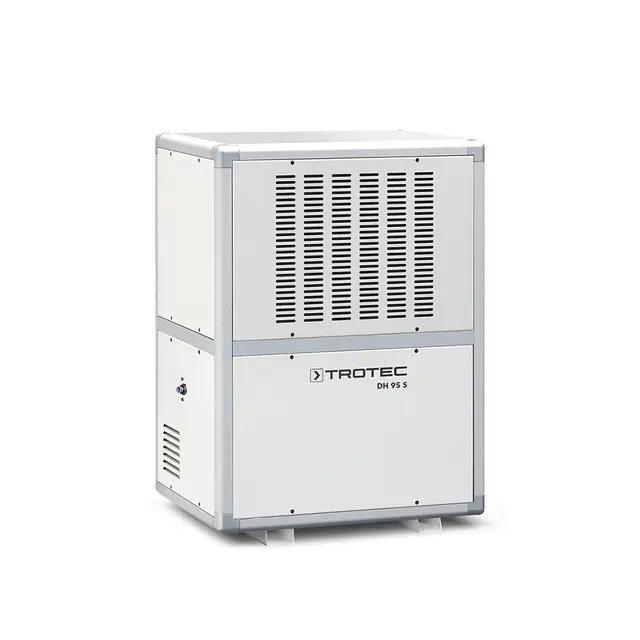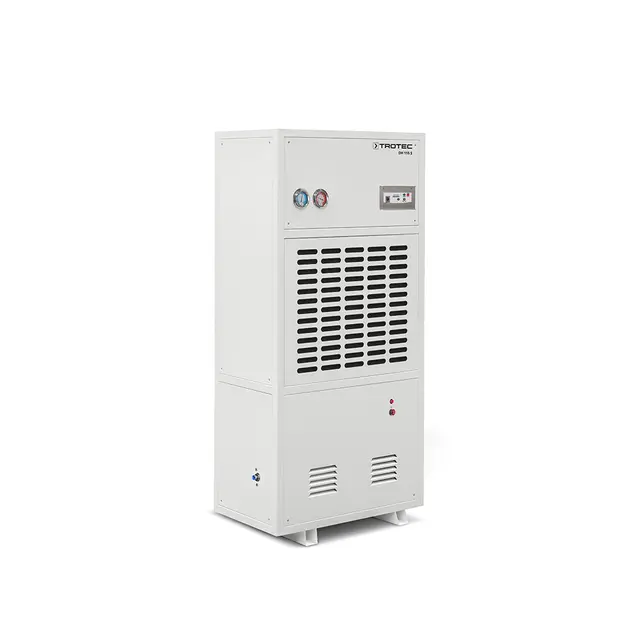The role of dehumidification in effective warehouse storage

- Home
- Insights
- Humidity control and drying insights
- The role of dehumidification in effective warehouse storage
From classic cars and family heirlooms, to cardboard and food supplies, warehouses across Europe house a wide assortment of items that may be susceptible to high humidity levels. Discover why using refrigerant dehumidification solutions keeps this threat at bay to preserve the quality and value of these assets.
When you store something in a warehouse, you expect it to remain in the same condition when you return to it at a later date. However, that very much depends on the nature of the environment within the warehouse, especially when it comes to humidity.
As we will break down in the course of this article, a lack of humidity control can gradually wear away at the quality of these items. Eventually, it can render them unusable and potentially worthless to either your business or to the person who stored their goods with you.
Read on to find out the consequences of an overly humid warehouse climate, and how you can tackle this issue with an effective Calorex dehumidification unit.
Why is climate-controlled storage important?
When most people think of climate control, their minds immediately turn to temperature. While this is important to manage within a warehouse, high humidity levels can often cause even more damage to products by degradation.
Prestige cars, luxury clothing, electrical appliances, perishable foods - all these and more are susceptible to damage if there is too much moisture in the air around them. Especially hygroscopic materials, such as cardboard/packaging.
The impact of this high humidity will depend on the type of products you have in storage, but in general can be split into two camps: mould and corrosion.
Mould
If humidity levels are in excess of 70%RH (relative humidity), this is the ideal conditions for mould to grow on items. Once mould forms it is difficult to fully remove, and for items like food, drinks and clothing, it can render them completely unusable.
This can lead to costly losses of stock and, if you are storing these items on behalf of another person or organisation, this can severely hurt your relationship with them and your wider reputation in the industry.
Plus, particularly in air-tight storage environments, the development of mould can present significant health risks to anyone who enters the warehouse, as the spores spread from the mould into the atmosphere.
Corrosion
At 60%RH and over, ferrous metals will begin to rust and corrode at a rapid rate, damaging the quality of these materials. For instance, if you are storing a classic car, the aged steel and upholstery of these vehicles can rapidly be overrun by rust and other moisture-related damage.
This naturally hurts the value and usability of these items, and will require costly repairs in order to treat the corrosion and restore them to their original state. In the case of classic cars or other expensive metallic goods, a failure to keep humidity levels in check can send costs skyrocketing.
Alongside the primary threats of mould and corrosion, excessive amounts of moisture can naturally degrade the condition of materials and damage the components within electrical appliances - water and electric devices are never a pleasant mix.
Why is heating not enough to handle this issue?
Many in the past have turned to heaters as a way to resolve the humidity problem. But, while this will reduce the relative humidity in the environment, it does not get at the heart of the problem, which is removing moisture from the atmosphere.
Heating alone cannot do this - it can only mask the real issue. By not removing the moisture, the risks of mould growth and corrosion still exist for your stored items. Moreover, it can actually exaggerate condensation and increase humidity significantly at times when the heating is not running, such as overnight.
Plus, consistently heating a warehouse, particularly a large one, consumes a lot of energy, making this an extremely inefficient and expensive way to resolve the problem.
Meeting storage needs with refrigerant dehumidifiers
Instead, a far more cost-effective and energy-efficient approach that actually targets the moisture in the atmosphere is the use of refrigerant dehumidifiers.
Harnessing the efficiency of heat pump technology, refrigerant dehumidifiers actively remove the moisture from the air in a space and condenses it internally. It then releases warm, dry air back into the environment at a controlled, comfortable humidity level.
As an example, our customers at Moss Automotive use a selection of Calorex dehumidifiers to provide the optimal conditions for classic car storage - maintaining the temperature at 15ºC and the relative humidity at 55% at all times.
By honing directly in on the moisture within the warehouse, refrigerant dehumidifiers maintain a controlled level of humidity, preserving the quality of the items within it. And, it does this at running costs that are 4-5 times cheaper compared to an equivalent heating solution.
This not only greatly reduces the risk of items becoming devalued or unusable, but can also represent a competitive advantage for your business over other storage facilities. People will be more willing to pay a premium to store items in a properly climate-controlled dry storage space, which you can offer for a relatively low investment in these dehumidification systems.
Why a refrigerant dehumidifier over a desiccant dehumidifier?
A desiccant dehumidifier can just as effectively target the moisture in the air in the same way a refrigerant dehumidifier can. In fact, desiccant units are better at achieving significantly lower humidity levels in locations where this is required.
However, for the majority of warehousing environments, we would recommend a refrigerant dehumidifier for a variety of reasons:
They are more economical to run while still able to keep humidity levels at a comfortable level for most purposes
They provide a high airflow within the warehouse, which helps to prevent mould from growing on items
They are easier and less expensive to install, as these units do not require professional ducting like a desiccant dehumidifier requires
Because of this ease of installation, it is much more feasible to scale your solution if the size of your warehouse grows over time - you can simply install additional units to cover this larger area, rather than a more complicated removal and replacement
Choosing the right dehumidifier for your warehouse
Selecting the appropriate refrigerant dehumidifier depends on several factors:
The size of your space
The volume and layout of your warehouse or storage facility will determine how many and how powerful a dehumidifier you will require to ensure that a consistent humidity is maintained in the areas required. For instance, a bigger space would likely benefit from a large-capacity unit, such as our DH 150 or DH 300.
Plus, this will also decide on where your unit(s) need to be positioned to deliver the necessary coverage.
The products you store
The nature of the products you are keeping will determine what humidity level needs to be maintained to prevent damage. For example, as rust develops at a lower relative humidity than mould (60%RH compared to 70%RH), your chosen dehumidifier will need to be capable of keeping humidity beneath that set point.
Process or preservation?
Finally, is the purpose of your warehouse or building to actively dry out items stored in it, such as a drying room? Or does it just need to preserve their condition throughout their time in storage? The answer to these questions will influence the dehumidifier that you require.
As highly experienced experts in this industry, our team can assess your warehouse and propose the most suitable Calorex refrigerant dehumidifier to meet your needs for the lowest cost of investment.
We also have a wide range of desiccant solutions as well if these are required in your circumstances. Whatever your needs, our products and expertise ensure that we can find the most effective and efficient system for your specific warehouse.
Enhance your warehouse with quality climate control
Hopefully this has given you a deeper understanding of the importance of dehumidification in protecting the condition of stored items for longer, and why offering climate-controlled storage can heighten the value of your service.
If you’d like to learn more about our wide range of commercial solutions, please get in touch by completing the form below.
Related products
Featured insights

Discover how humidity control is critical to effective data storage

Purpose-built solutions for industry leaders

Explore how effective humidity control preserves vintage motors in the most efficient way possible.
Need help with choosing the right solution? Our team of over 100 climate control experts can assist.
You can also reach out or join the discussion on our Social Media. Check out our LinkedIn page.












